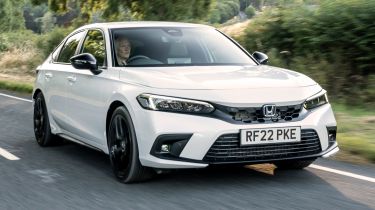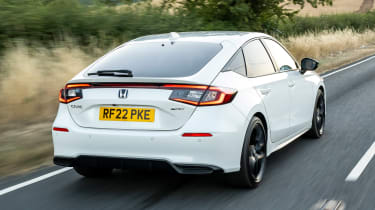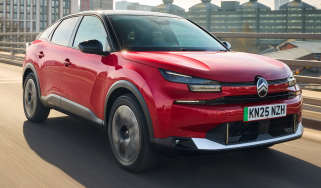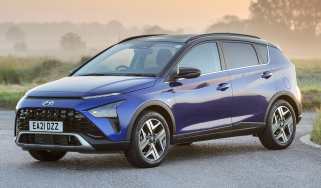New Honda Civic 2022 review
The all-new hybrid Honda Civic has finally arrived, but what’s it like? We hit UK roads to find out...

Verdict
There is a reason why practical SUVs now rule the roost when it comes to the family-car market, but the Civic is a spacious hatchback that can give many SUVs a run for their money. It’s better built and even sharper to drive than before, and the hybrid-only powertrain should prove usefully frugal in a time when we’re all placing greater focus on the rising cost of living. If you don’t want an EV just yet, the new Civic is a very strong contender in its class.
Believe it or not, the Honda Civic is now 50 years old. In that time we’ve seen it morph from a small, city-suited runaround, into a larger, more family-focused model. The car you see here is the 11th iteration of the Japanese mainstay.
Honda will tell you the design has evolved, with its “open-feeling glassy cabin” and “sleek, light body”, but ultimately it’s still recognisable as the maker’s alternative to the Volkswagen Golf. Less complicated surfacing makes it a cleaner-looking car overall.
But it’s under the skin and in the cabin where the biggest changes have taken place. The Civic – forthcoming Type R aside – is now hybrid only, with just one powertrain available to UK buyers.
Used - available now

2018 Honda
Civic
33,104 milesManualPetrol1.0L
Cash £13,650
2021 Honda
Civic
24,475 milesAutomaticPetrol1.5L
Cash £17,687
2021 Honda
Civic
56,617 milesManualPetrol1.0L
Cash £10,587
2021 Honda
Civic
69,112 milesManualPetrol1.5L
Cash £13,587Lifted from the CR-V, the 2.0-litre e:HEV system has been tweaked and refined to make it more powerful, but also quieter and more efficient. Unlike hybrid systems from rival manufacturers, most of the time the engine acts as a generator to power the battery rather than the wheels – making it feel more electric, more of the time.
The engine can, however, send drive straight to the front axle under heavy load or at higher speeds. The e-CVT transmission isn’t a gearbox in the conventional sense, but the aforementioned set-up should, in theory, make the Civic’s powertrain smoother and prevent the sudden rise in revs you might find in something with a normal CVT box.
And it works. Parking or manoeuvring around town, the Civic stays almost silent. You’ll notice very little reliance on the petrol engine, with the 1.05kWh battery doing the legwork in most situations. Despite the Civic’s steeply-raked rear screen, we never found visibility an issue, either.
The electric motor means it always feels alert, too. Whether that’s away from traffic lights or nipping into gaps, throttle response is strong. Accelerating up to the national speed limit the Civic feels pretty quick; 0-62mph takes 7.9 seconds.
Find yourself on a more challenging A or B-road and the new Honda Civic is pleasingly rewarding to drive, which bodes well for the Type R. The front end feels pointy, with plenty of grip, and the weighty steering and good body control only add to the sense of agility.
That e-CVT transmission continues to show itself in a positive light even here – somewhere a Toyota hybrid might come undone. With the set-up controlled electronically rather than mechanically, the Honda can manipulate steps into the process, giving the feel of conventional transmission ratios. It works well, especially in conjunction with the subtle but effective exhaust burble sent through the speakers when the car is in Sport mode.
The paddles on the steering wheel don’t mimic gear changes, but instead control the regenerative braking. While the most aggressive setting won’t allow for one-pedal driving, it’s stronger than you might think, and helps slow the car significantly without the need for discs and pads. We found this setting particularly handy around town.
The suspension is just the right side of firm, with complex damping that takes the edge off sharp bumps or deep potholes. It means the Civic has a tendency to fidget slightly on broken or uneven roads, but it finds a rhythm on the motorway. The only true downside to the driving experience is the significant road noise generated by the large 18-inch wheels and wide tyres.
Elsewhere, the cabin takes a welcome step up in quality and functionality. The materials used are plush to the touch and the seats are comfortable. The physical climate controls operate with a satisfying click – no touch-sensitive buttons or sliders here – and there’s enough storage space for odds and ends.
The infotainment system still isn’t the slickest; it could be more responsive and the graphics already look a little dated, plus it’s angled ever-so-slightly away from the driver – presumably a hangover from this car’s European-focused (left-hand-drive) development programme. It’s not a dealbreaker, though, and the part-digital dials are clear and easy to read, even if we would like a bit more configurability.
Practicality is good, if not class leading. Though in reality, it’s the Civic’s plethora of SUV-shaped rivals that really show it up in this regard. The 410-litre boot is 30 litres bigger than a Golf, but 110 litres smaller than a Volkswagen Tiguan. Our favourite mid-size SUV, the Hyundai Tucson, boasts more than 600 litres with the rear seats in place. It trounces the Honda with the seats down, too.
But how versatile a vehicle is doesn’t just come down to the size of its boot – or even how much room there is in the back. Head and leg room in the rear are adequate, no less, but if you’re used to the height of an SUV and regularly load kids or kit into the back, the Civic’s lower roofline may cause issues.
What’s unlikely to raise any unwanted concerns are running costs. Making this Civic hybrid-only means it’ll return (according to Honda) an impressive 56.5mpg. And with no plugs to contend with, those numbers should be quite achievable. Of course, company car drivers may be inclined to seek out one of the Civic’s PHEV or EV rivals – such as the Mercedes A 250 e, or Volkswagen ID.3 – on Benefit in Kind (BiK) costs alone.
There are three trims to choose from when ordering your new Civic, with the majority of buyers (45 per cent) expected to opt for the mid-range Sport we’re driving here. Yet entry-level Elegance cars (30 per cent of sales) get a nine-inch touchscreen with Apple CarPlay and Android Auto, a reversing camera, all-round parking sensors, keyless entry and start, plus heated front seats and a suite of safety kit. All for £360 per month on a three-year PCP deal.
Sport brings a racier look, with 18-inch alloy wheels, gloss-black mirror caps and window surrounds, synthetic leather for the seats, and wireless phone charging. Advance (the final 25 per cent of sales) cars get a panoramic roof, a 12-speaker BOSE stereo, electric front seats and a bigger instrument cluster. For just £1,000 more than the base car (or £20/month on a three-year deal with a circa-20 per cent deposit), the Sport is our pick.
| Model: | Honda Civic e:HEV Sport |
| Price: | £30,595 |
| Engine: | 2.0-litre 4cyl petrol-electric hybrid |
| Power/torque: | 181bhp/315Nm |
| Transmission: | e-CVT automatic, front-wheel drive |
| 0-62mph: | 7.9 seconds |
| Top speed: | 112mph |
| Economy/CO2: | 56.5mpg/113g/km |
| On sale: | Now |
















